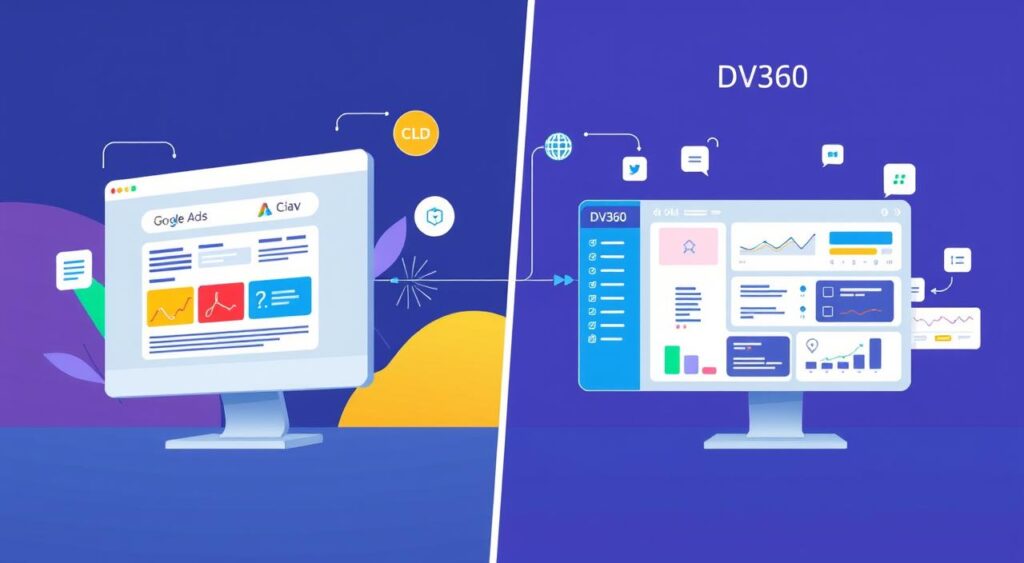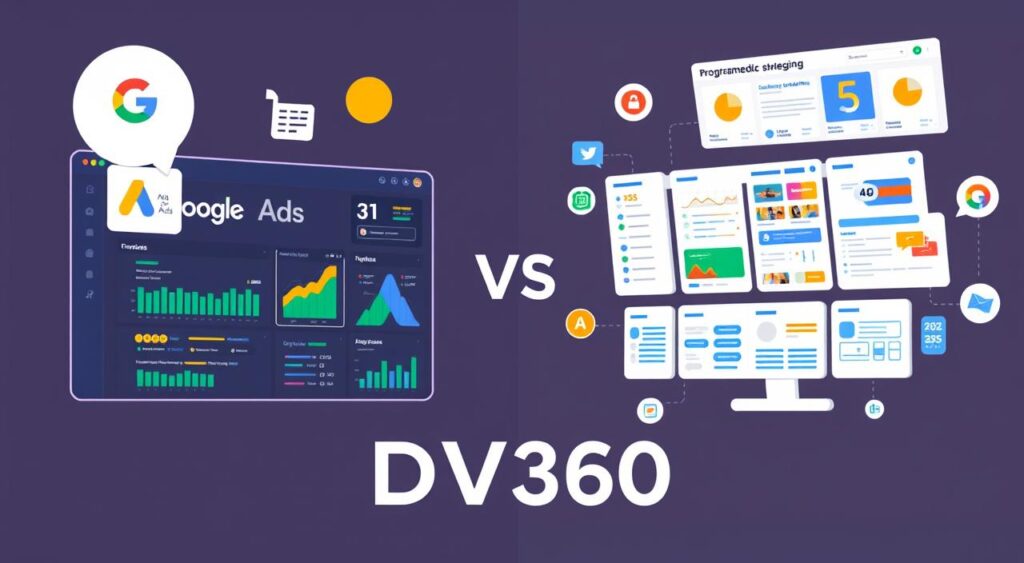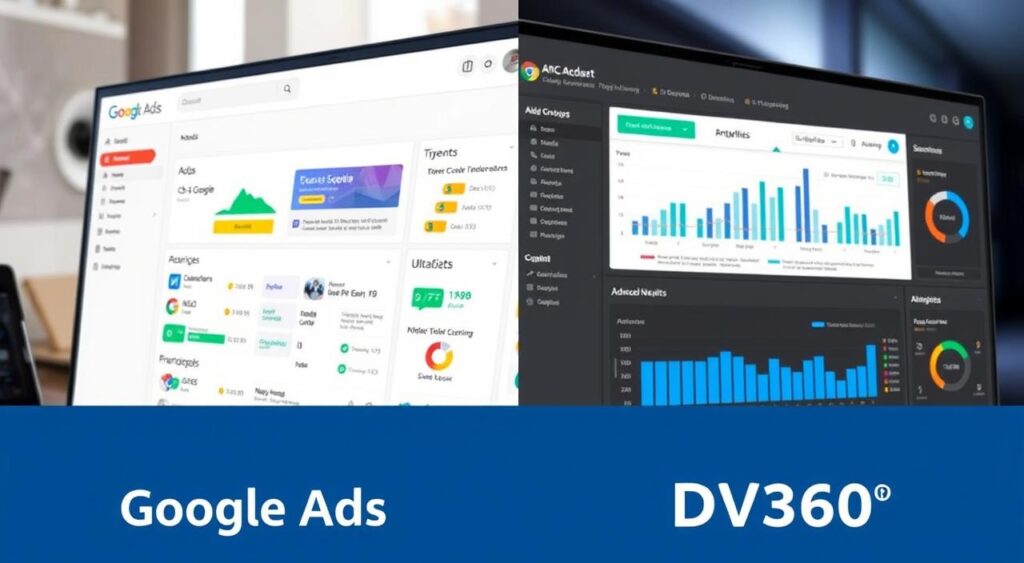If you work in digital marketing, you’ve likely heard of Google Ads and Display & Video 360 (DV360). Both are key to your strategy. But knowing how they differ is crucial for success.
In this article, we’ll explore Google Ads and DV360 in detail. We’ll look at their features, targeting options, and when to use them. By the end, you’ll know which platform fits your needs best.

Key Takeaways
- Google Ads and DV360 are two distinct advertising platforms offered by Google, each with its own unique features and capabilities.
- Google Ads is a self-service platform focused on search engine marketing and display advertising, while DV360 is a more comprehensive programmatic advertising solution.
- DV360 offers advanced targeting, audience segmentation, and cross-channel optimization, making it a powerful tool for complex advertising campaigns.
- Google Ads is generally more beginner-friendly and suitable for smaller businesses or those new to digital advertising, while DV360 caters to larger enterprises and agencies with more sophisticated advertising needs.
- Understanding the differences between these platforms will help you make the most informed decision for your digital advertising strategy.
Understanding Google Ads and DV360: A Comprehensive Overview
In the fast-paced world of digital ads, Google Ads and Display & Video 360 (DV360) stand out. They’ve changed how businesses reach their audience. Each offers many features to meet different advertising needs.
What is Google Ads Platform?
Google Ads, once AdWords, is a top ad solution from Google. It lets businesses manage their online ads. They can target customers through search, display, and video ads. Over time, Google Ads has grown, adding more features to help advertisers succeed.
Introduction to Display & Video 360 (DV360)
Display & Video 360 (DV360), or DoubleClick, is a strong ad platform. It helps agencies and big companies plan, buy, and measure their digital ads. Since Google bought it in 2008, DV360 has grown. Now, it offers a wide range of ad spaces, including display, video, and connected TV.
Key Features of Both Platforms
- Targeting and audience segmentation: Both Google Ads and DV360 let advertisers target specific audiences. They use demographics, interests, and more to find the right people.
- Campaign management and optimization: These platforms have tools for managing and improving ads. Advertisers can set budgets, track performance, and adjust strategies.
- Measurement and reporting: Google Ads and DV360 have detailed analytics. They help advertisers see how well their ads are doing and make informed choices.
- Creative and ad formats: The platforms support many ad types. From text and banners to videos and interactive ads, they help create engaging ads.
Google Ads and DV360 are key platforms for businesses and agencies. They offer a wide range of tools to help drive successful digital marketing strategies.
What is the difference between Google Ads and DV360?
Google Ads and Display & Video 360 (DV360) are top choices for digital ads. Knowing their differences is key to picking the right one for your business.
Google Ads is great for small to medium-sized businesses. It’s easy to use and offers simple ad options. DV360, on the other hand, is for big companies and agencies. It has more tools for complex campaigns.
| Google Ads | Google DV360 |
|---|---|
| Suitable for small to medium-sized businesses | Designed for enterprise-level advertisers and agencies |
| Offers a wide range of ad formats, including search, display, and video | Provides a broader scope of advertising options, including programmatic display, video, and connected TV (CTV) |
| Focuses on simplicity and ease of use | Offers more advanced features and customization for experienced advertisers |
| Suitable for businesses with limited advertising budgets | Typically requires a higher minimum spend commitment |
Google Ads has many ad formats like search, display, and video. DV360, however, offers more, including programmatic display, video, and connected TV (CTV).
Choosing between Google Ads and DV360 depends on your business size, needs, and budget. Knowing these differences helps pick the best platform for your goals.

Platform Accessibility and User Interface Comparison
Google Ads and Display & Video 360 (DV360) have different user interfaces and accessibility. It’s important for advertisers to know how easy each platform is to use. This helps them choose the best one for their digital advertising needs.
Learning Curve and User Experience
Google Ads is known for being easy to use. Its simple design makes it great for both small and big businesses. DV360, however, is seen as more complex. It has advanced features that are perfect for experienced advertisers.
Dashboard and Navigation Features
The dashboards of Google Ads and DV360 are quite different. Google Ads has a clean layout that shows how your campaigns are doing. DV360’s dashboard is more detailed and customizable, ideal for those who need to analyze data deeply.
Campaign Management Tools
- Google Ads has tools like audience targeting and automated bidding. These make managing campaigns easier.
- DV360 has tools like advanced audience segmentation and real-time bidding. These are great for detailed control over campaigns.
Choosing between Google Ads and DV360 depends on what you need. Google Ads is good for beginners. DV360 is better for those who want more control and customization.

“Selecting the right platform is crucial for the success of your digital advertising campaigns. Understanding the differences in user experience, dashboard features, and campaign management tools can help you make an informed decision that aligns with your business objectives.”
Targeting Capabilities and Audience Reach
Google Ads and Display & Video 360 (DV360) are great for reaching your audience. Google Ads uses lots of user data to target your audience. You can target by demographics, behavior, and context.
DV360 is great for programmatic ads. It has a huge inventory of ads across the web. You can use data from many sources to make your ads more personal and targeted.
DV360 is also good at finding specific audiences. This is helpful if you want to reach certain groups. It’s perfect for marketers who need to target specific demographics or interests.
| Targeting Capabilities | Google Ads | DV360 |
|---|---|---|
| Demographic Targeting | ✓ | ✓ |
| Behavioral Targeting | ✓ | ✓ |
| Contextual Targeting | ✓ | ✓ |
| Advanced Audience Segmentation | – | ✓ |
| Access to Third-Party Data | – | ✓ |
Choosing between Google Ads and DV360 depends on your campaign needs. Think about your audience targeting, display ads, and programmatic advertising goals.
Budget Management and Cost Structures
Google Ads and DV360 have different ways to handle budgets and pricing. It’s important to know about minimum spend, pricing models, and ROI to make smart choices.
Minimum Spend Requirements
Google Ads has a low minimum spend, making it easy for small and medium businesses. DV360, however, needs a bigger budget, fitting larger companies better.
Pricing Models and Fee Structures
Google Ads uses a pay-per-click (PPC) model. Advertisers only pay when people click on their ads. DV360 has a more complex pricing, with a percentage fee on ad spend and other charges.
ROI Considerations
- Google Ads makes it easy to see ROI because of its PPC model. It clearly shows how ads lead to sales.
- DV360 offers advanced targeting and optimization tools. This can lead to better ROI for some.
- But, DV360’s extra fees might lower ROI compared to Google Ads. It depends on the advertiser’s goals and budget.
Choosing between Google Ads and DV360 depends on your needs, audience, and ROI goals. Analyzing each platform’s features and costs is key to getting the most from your budget.
Read More: What is PPC or Pay-Per-Click Advertising? A Complete Guide
Inventory Access and Publisher Networks
Google Ads and DV360 have different features for ad inventory and publisher networks. The Google Display Network is key for Google Ads. It reaches millions of websites, mobile apps, and YouTube channels. This means your ads can be seen by many people.
DV360 takes a more detailed approach. It gives access to more ad inventory from various networks. This lets advertisers target specific groups and strategies more easily.
| Feature | Google Ads | DV360 |
|---|---|---|
| Ad Inventory | Primarily the Google Display Network, which includes millions of websites, mobile apps, and YouTube channels. | Access to a wider range of publisher networks and programmatic inventory, offering more flexibility and customization. |
| Reach | Extensive reach through the vast Google Display Network, ensuring broad exposure for your ads. | Broader reach across multiple publisher networks, allowing for more targeted and niche-specific campaigns. |
| Customization | Limited customization options, as the focus is on the efficiency and simplicity of the Google Display Network. | Greater customization and control over ad inventory, enabling more tailored and specialized campaigns. |
Choosing between Google Ads and DV360 depends on your goals and audience. If you want wide reach and simplicity, Google Ads might be best. But for more control and variety in publisher networks, DV360 is a better choice.
Conclusion
Google Ads and Display & Video 360 (DV360) are two different digital ad platforms. Google Ads is great for small to medium-sized businesses. It’s perfect for search engine marketing and basic display ads. DV360, on the other hand, is more complex. It’s designed for big businesses and agencies with complex ad strategies.
Google Ads is easy to use and perfect for beginners. It’s simple and straightforward. DV360, however, offers advanced targeting and a wider range of ads. It’s better for big, detailed campaigns.
Choosing between Google Ads and DV360 depends on your business goals and ad needs. Knowing what each platform offers helps you make the right choice. This choice will help you meet your digital advertising strategies goals, whether you pick Google Ads vs DV360 or both.
FAQ
What is the difference between Google Ads and DV360?
Google Ads and Display & Video 360 (DV360) are both from Google. But they serve different needs. Google Ads focuses on search and display ads. DV360 offers more, with a wide range of inventory and advanced targeting.
What is Google Ads?
Google Ads is a platform for creating and managing ads. It’s easy to use and great for beginners. It helps you reach people online.
What is Display & Video 360 (DV360)?
DV360 is a top-level platform for advanced ads. It has tools for targeting and measuring ads. You can use it for display, video, and TV ads.
What are the key features of Google Ads and DV360?
Google Ads has features like keyword targeting and ad scheduling. DV360 offers more inventory and advanced tools. It also works with other Google products.
What is the difference in target audience and use cases between Google Ads and DV360?
Google Ads is good for small businesses and basic ads. DV360 is for big companies and advanced ads. It’s for those who need more features.
How do the user interfaces and campaign management tools compare between Google Ads and DV360?
Google Ads is easy to use, perfect for beginners. DV360 is more complex but offers better tools. It has advanced features for managing ads.
What are the differences in targeting capabilities and audience reach between Google Ads and DV360?
Google Ads uses keywords and demographics. DV360 has more options, like behavioral targeting. DV360 also reaches more people through its programmatic ads.
How do the budget management and cost structures differ between Google Ads and DV360?
Google Ads has lower costs and simple pricing. DV360 costs more but offers better budget tools. It’s for those who need more control over their budget.
What are the differences in inventory access and publisher networks between Google Ads and DV360?
Google Ads uses the Google Display Network. DV360 has more inventory, including premium sites. This means better ad placement for DV360 users.
𝐒𝐰𝐚𝐠𝐚𝐭 𝐆𝐚𝐰𝐚𝐝𝐞
Digital Marketer | Content Creator | Growth Strategist
With 2 years of hands-on experience in the dynamic world of digital marketing, Swagat Gawade specializes in crafting compelling strategies that drive growth and engagement. From managing ad campaigns to optimizing SEO, Swagat has a proven track record of boosting brand visibility and achieving measurable results.
Key skills:
𝐒𝐨𝐜𝐢𝐚𝐥 𝐌𝐞𝐝𝐢𝐚 𝐌𝐚𝐫𝐤𝐞𝐭𝐢𝐧𝐠: Building impactful campaigns that resonate with audiences.
𝐂𝐨𝐧𝐭𝐞𝐧𝐭 𝐌𝐚𝐫𝐤𝐞𝐭𝐢𝐧𝐠: Creating engaging, high-quality content tailored to target markets.
𝐒𝐄𝐎 & 𝐒𝐄𝐌 𝐄𝐱𝐩𝐞𝐫𝐭𝐢𝐬𝐞: Ensuring brands rank high and stay competitive in search results.
𝐀𝐧𝐚𝐥𝐲𝐭𝐢𝐜𝐬 𝐏𝐫𝐨𝐟𝐢𝐜𝐢𝐞𝐧𝐜𝐲: Leveraging data to refine strategies and enhance ROI.
Swagat’s passion for learning fuels a constant pursuit of innovative marketing solutions, making him a valuable asset in today’s fast-evolving digital landscape.


